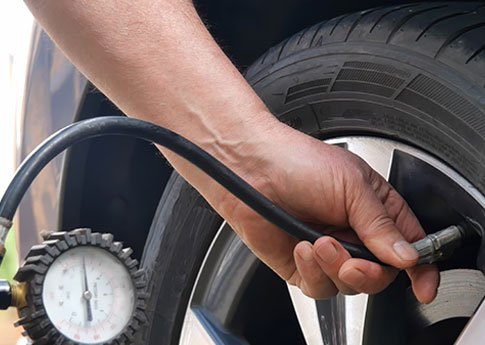What’s the right tire air pressure for your car?

The recommended tire pressure for your vehicle is the one specified by your vehicle manufacturer. It may vary depending on your vehicle model, the season, and the tire design you use. Checking your tire air pressure regularly is crucial, since improper inflation affects both safety and vehicle performance. Here’s everything you need to know to keep your tires at the right pressure.
How to know the correct tire pressure for your car
The recommended tire pressure can be found in your owner’s manual. You’ll also find it on a label inside the door frame, near the gas tank, or inside the glove compartment.
Tire pressure is usually measured in PSI (pounds per square inch) or in bars. The exact number depends on your tire type, vehicle model, and load conditions.
When and how to check your tire pressure
Here’s how to measure tire pressure accurately:
- Remove the valve cap on each tire
- Press the tire gauge firmly onto the valve. If you hear air escaping, adjust the position.
- Read the air pressure on the gauge or digital screen. Compare it with the manufacturer’s recommended tire pressure.
- If the pressure is too low, use an air compressor or a public pump at a gas station to inflate your tires
- If the pressure is too high, release air with the small pin on the tire gauge.
- For tires filled with nitrogen, top up only with nitrogen, except in emergencies.
Don’t forget to check the spare tire pressure if your vehicle has one.
Prefer a visual guide? Watch this quick video on how to check your tire pressure.
Why you should check your tire pressure
An underinflated tire increases the contact area with the road surface. The results? Longer braking distances, reduced handling, higher fuel consumption, faster wear and tear, and an increased risk of a tire blowout.

“Wondering about the right electric vehicle (EV) tire pressure? Monitor your EV tire pressure more often, as underinflated tires can reduce your battery range. When replacing, choose tires with the proper load index specified inside your driver-side door. Otherwise, your tires will wear out faster and vehicle stability may suffer. With the right EV tires, pressure stays as stable as with a gas-powered car.”
Sylvain LégaréResearch Analyst, Mobility, CAA-Quebec
On the other hand, an overinflated tire touches the road only on the centre of the tread. With reduced contact surface, you lose traction, stability, and tire lifespan. High pressure also accelerates wear on steering and suspension components.
Why tire pressure drops
Tire rubber is naturally permeable, allowing slow air loss even without a visible leak. Temperature changes also affect pressure: in cold weather, air contracts, causing pressure to drop.
Other factors include small punctures, a damaged valve, or a bent rim.
Tire pressure in winter: Stay extra vigilant
In winter, tire pressure drops more quickly due to the cold. On average, a 6°C temperature drop lowers pressure by about 1 pound per square inch (PSI). For example, if your winter tires were installed at 10°C, you could lose up to 5 PSI when it drops to -20°C.
This can leave you with underinflated tires—even if they’re not defective—bringing all the risks mentioned earlier. That’s why this quick monthly check is essential, even if it means braving the cold for a few minutes.
Key Takeaways for Peace of Mind on the Road
- Check your tire pressure regularly: a quick look can make all the difference for your safety,
- Just a few minutes of checking can prevent major problems.
- Don't hesitate to ask a trusted mechanic for advice if needed.

Benefit from personalized advice
Do you have questions about gas-powered or electric vehicles, driving, or need recommendations to find an Approved Auto Repair Service?
